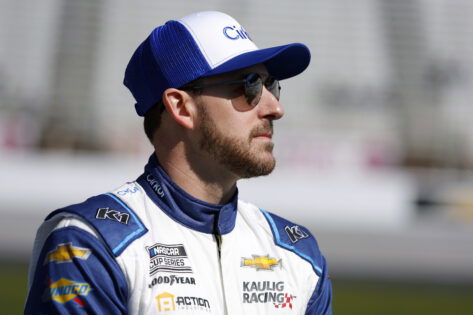Pressure at NASCAR’s Watkins Glen peaked as the clock ticked down. Daniel Hemric, running on fresh tires and positioned for a late-race charge, found himself side-by-side with Corey Heim, one of the series’ dominant forces, into the final corners. The truck’s rumble echoed through the paddock, but a critical moment would shape the narrative. Hemric, well-known for his calculated aggression, appeared poised for an upset.
Yet, as fans watched intently from the grandstands and team radios buzzed with strategy, a split-second decision would draw the spotlight not just on the winner’s celebration but on the fine margins that separate triumph from regret in the Truck Series’ most intense showdown of the year. The immediacy of the duel rested not in history, but at the moment itself: strategies, tire gambles, and raw road course bravado that had the crowd on edge as the white flag flew.
Hemric’s grip vs. Heim’s grit in final-lap NASCAR drama
As the laps wound down at NASCAR’s Watkins Glen, every strategic gamble came sharply into focus. Daniel Hemric, rejoining the front pack on newer tires than the leaders, had played his cards differently than much of the field. The crew’s choice to pit late was designed to give him the upper hand in grip and speed, a plan increasingly common on road courses where tire wear can make a dramatic difference in the closing laps.
The stage was set when Hemric found himself locked behind Corey Heim, who had controlled much of the race but was now managing older rubber. The tension escalated on the white flag lap. With the crowd on its feet and spotters calling out every move over the radio, Hemric made his bid. “I had a much more tire advantage,” he explained post-race, “and just still thought we’re gonna be in the mix there… and I shallow-dove in too much… I got to the side of them… they’re off of one… on the white flag lap… got into the door…” His aggressive dive-bomb maneuver in Turn 1, meant to capitalize on extra grip, momentarily put him alongside Heim but also made for a near spin, robbing him of momentum.
Best career road-course finish (P2) and 10th top-10 finish in the last 11 races for @DanielHemric! pic.twitter.com/Tnnmu6dx7k
— NASCAR CRAFTSMAN Trucks (@NASCAR_Trucks) August 9, 2025
These moments encapsulate the invisible factors at play beyond just who’s in the lead: crew chiefs taking calculated risks, engineers predicting tire fall-off, and drivers weighing instant aggression against patience. Hemric tried to regroup. “I had a run to him down into ten and drove in with an open mind… when he missed… I was leaving… let me get to the left… I thought I was gonna have a shot…” Yet as the track wound through the high-speed esses and into the heavy-braking zones, Heim’s poise under pressure despite tire disadvantage caught Hemric off guard: “I was completely blown away by the amount of potential he still had.”
The implications for Hemric were deeper than just a lost race. “I’m gonna replay that last couple … for a while… I got six days… so next race… yeah, this one will be on my mind till then, brother.” He didn’t mince words; this was a painful near-miss for a team searching for victory lane and vital playoff points. His open debrief captured the complexity of modern NASCAR Truck Series racing, where data-driven strategies and lightning responses must coalesce perfectly under pressure. The dynamic between track position, tire life, and psychological warfare in door-to-door battles remains central to outcomes, and so does the crushing weight of a single miscalculation.
Tight margins and Watkins Glen’s rising stakes
Ultra-close battles defined the NASCAR Truck Series competition at Watkins Glen, and bold strategy calls, underlined by Hemric’s and Heim’s duel. Corey Heim’s win, his sixth of the season, cemented his position as the series leader while showcasing the razor-thin margins at the front. The race saw late cautions, aggressive restarts, and road-course specialists in the field, ramping up pressure for full-time contenders.
“I got behind on that last stage,” Heim said post-race. “I was scratching and clawing, trying to get back through the field. … I had my brakes pretty much go out completely on me on that long green-flag run. I blew the bus stop, and I made a lot of mistakes myself.”
The Glen’s layout is a fast, technical road course, which frequently rewards tire strategy and precise passing. Hemric’s approach, leveraging tire advantage, aligned with a broader trend among teams opting for late-race pit stops with hopes of charging through the pack. Yet, as demonstrated, real-time traffic and defensive lines can neutralize advantages. The duel forced contenders like Hemric into riskier moves in pursuit of passing opportunities.
Importantly, this result tightens the playoff picture, crowns Heim’s consistency, and highlights how in NASCAR, a single lap’s decisions can ripple through the championship fight. With Hemric and other competitors now focusing on the next race, the narrative at Watkins Glen serves as a reminder: in the Truck Series, not only speed but impeccable judgment is essential for converting chances at glory into victory and recovering quickly when they fall just short.
The post Truck Series Star Admits Costly Misjudgment Amidst Watkins Glen Showdown appeared first on EssentiallySports.



